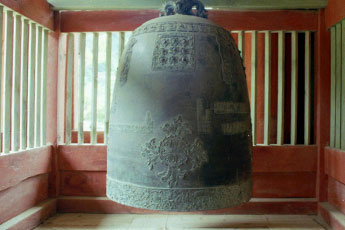Cultural Heritages
This is a pagoda of the United Shilla era, and remains at the old site of a temple at Mulgeol-ri, Naechon-myeon. The temple is supposed to have been a considerably sizable one, judging from the remains, although its name is unknown. In general, this is a typical United Shilla Dynasty pagoda. It is thought to have been built comparatively late in the latter half of the 9th century, judging from the fact that the pole of the facet of each stylobate was reduced to one, and because the support of the roof stone on the 3rd floor was reduced to four layers, thus breaking the balance with the floor below.
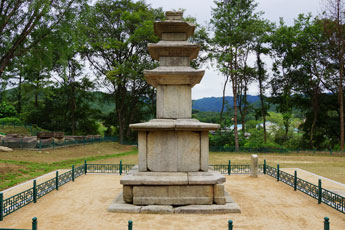
Lotus and vine patterns are carved at the center of the halo, which is of exactly the same shape as a ship. A flame pattern is gorgeously carved at the edges. Nine small-sized Buddhas are carved in the upper, right, and left sides, each forming different finger gestures. The pedestal supporting the halo is octagonal, comprising of three stories. In the lowest story, a lotus pattern is carved in each facet toward the ground, and, in each facet of the middle story, images of various Buddhist and guardian deities are carved so as to drive out evil spirits. The left end of the pedestal takes a semi-circular form with the full bloom of the lotus flower. Flower patterns carved in the lotus add to the magnificence. The halo and pedestal are thought to have been created at the end of the United Silla Dynasty, judging from the fact that the style is similar to those appearing after the 9th century.
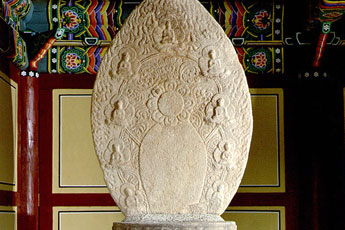
The pedestal is octagonal, consists of three parts, the upper, middle, and lower parts, and is of a style typical of the United Shilla Dynasty. On the lower part, there is a footstone carved with the pattern of a lotus flower on the octagonal support stone carved with a pattern of an incense burner and birds. On the middle part, the corner poles are carved on each facet of the octagon, and a standing statue of Bodhisattva with a head halo is carved inside of it. The upper part, forming a circular shape, has carvings of a triple lotus flower. It adds to the gorgeousness with decorative flower patterns using the petals of the lotus flower.
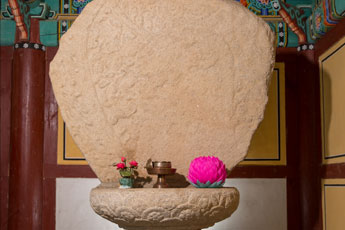
Turban-like hair is placed on the head, above which a topknot-shaped hair bundle is risen. A slightly lowered head produces a rich but decorative impression, thanks to the pointed jaw. Clothes are thrown on both shoulders, lending a somewhat crude and heavy impression without strain or elasticity. Although wrinkles are shown from the shoulders through both arms down to both knees, it appears somewhat formal, for they run in parallel. The index finger of the right hand is covered by the left hand, which is a gesture opposite to that of the ordinary Vairocana. The pedestal, on which the Buddhist image is sitting, is octagonal and features the pattern of the lotus flower. Lotus flowers are carved on each of the upper and lower pedestals, and there are carvings on the middle pedestal of people making offerings at the front of Buddha one is playing an instrument. There is also a carving of an incense burner. We might suggest it is a Vairocana image showing a style typical of the latter part of the 9th century, judging from the flat expression of the body, and the loose, heavy, yet strain less winkles.
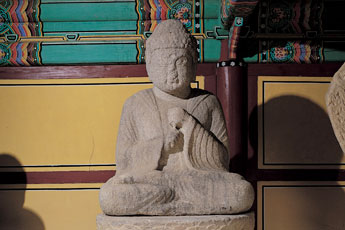
The pedestal in which the Buddhist image is sitting, takes an octagonal shape consisting of a middle and lower part. Each facet of the lower part has patterns. An incense burner and ‘Gareungbin-ga’, an imaginary bird, are also carved into the structure. Eight guardian deities are carved on each of the eight facets of the middle part. In the upper pedestal, the pattern of a full-bloomed lotus flower is carved. Although we cannot exactly read the expression of each part of the body due to deterioration, it shows the typical style of pedestals after the mid-9th century, which emphasized decorative features.
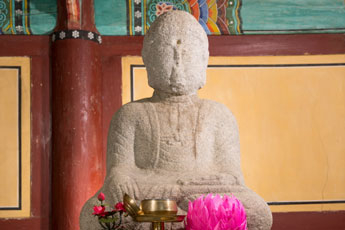
This pagoda is also referred to as the 4-Lion Pagoda, as it features four stone lions. It is a three-story pagoda on a two-story basement. An elephant is engraved on each surface of the lower basement, and it is decorated with flower-patterned carvings as was typical in the Goryo Dynasty. The stone lions were positioned at every corner of the upper basement so as to support the wide upper stone, the most peculiar element of this pagoda. There are lotus flower stands at the bottom and on the ceiling, surrounded by the four lions. Each body stone and roof stone was carved from a single stone. Three-layered props were carved on the roof stones, which are thin, plain, and slender supposedly because of the steep slope of the roofs. The four corners are slightly pulled back, forming fairly sharp angles. There remain four angled Noban, (support to decorate the peak of the pagoda), on top of the pagoda.
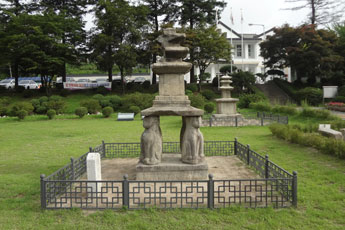
They used to hang a flag called a ‘dang’ at the entrance of a temple whenever there was an event. They called the pole hanging the ‘dang’ a ‘dang-gan’, and two poles supporting a ‘dang-gan’ were ‘dang-gan jiju’. By erecting these in front of temples, they indicated that it was a holy place.
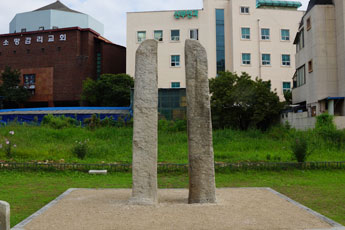
In this pagoda, the stylobate is too large for the body, breaking the total balance. This lends it the impression of a body being an attachment of the stylobate. It is thought that this pagoda was built in a period later than mid-Goryo, and the carvings in each part have been weakened.
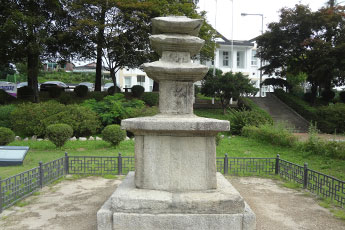
This is a temple bell built by Sainbigu, a Buddhist Priest who was active in Gyeong-gi and Gyeongsang Province during the reign of Sukjong in the Joseon Dynasty. Sainbigu was a priest of high virtue in the 18th century, as well as a craftsman who made the bells that became popular in the traditional Shilla region. Eight pieces of his works remained to date, each revealing different features. Among his works, this bell shows his highest level of maturity and creativity, together with the bell of Gimryong-sa, Mungyeong (Treasure No. 11-2). It expresses Dangjwa, part of a beating bell, quite uniquely.
